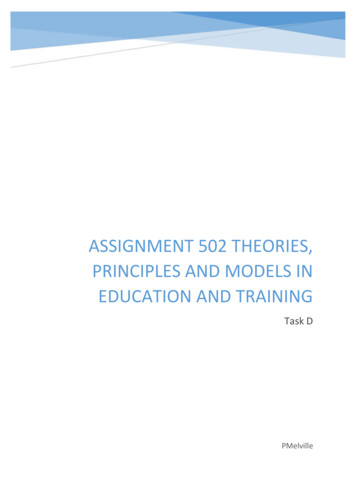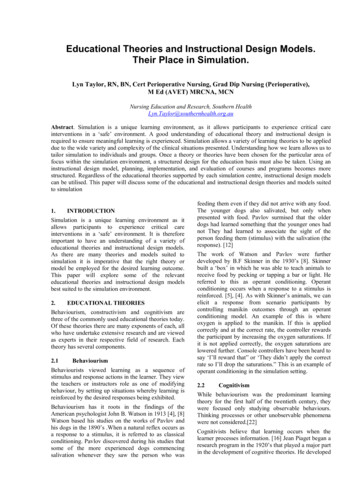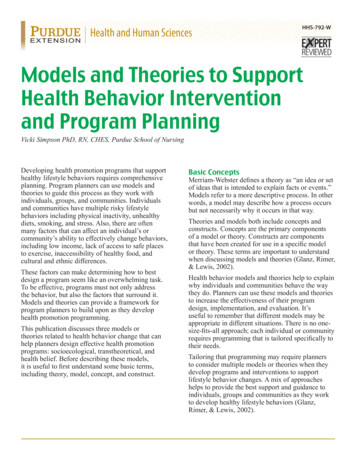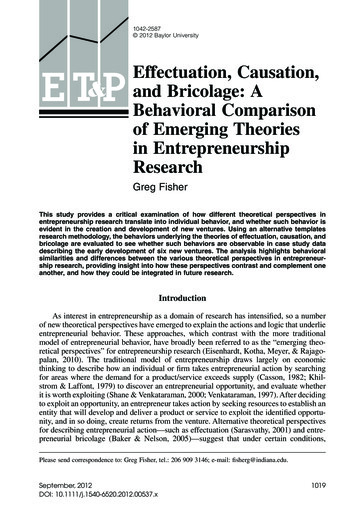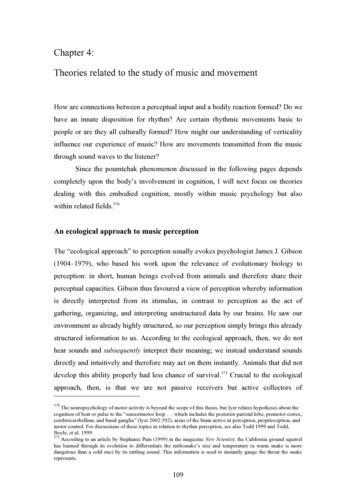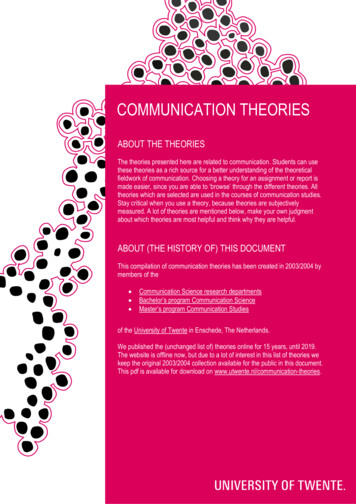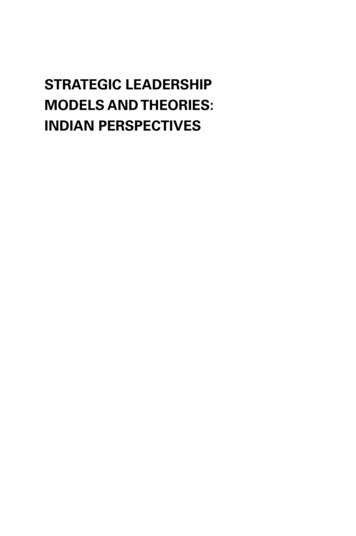
Transcription
STRATEGIC LEADERSHIPMODELS AND THEORIES:INDIAN PERSPECTIVES
This page intentionally left blank
Strategic LeadershipModels and Theories:Indian PerspectivesBySom Sekhar BhattacharyyaNational Institute of Industrial Engineering, Mumbai, IndiaSumi JhaNational Institute of Industrial Engineering, Mumbai, IndiaUnited Kingdom – North America – Japan – India – Malaysia – China
Emerald Publishing LimitedHoward House, Wagon Lane, Bingley BD16 1WA, UKFirst edition 2018Copyright 2018 Emerald Publishing LimitedReprints and permissions serviceContact: permissions@emeraldinsight.comNo part of this book may be reproduced, stored in a retrieval system, transmitted inany form or by any means electronic, mechanical, photocopying, recording orotherwise without either the prior written permission of the publisher or a licencepermitting restricted copying issued in the UK by The Copyright Licensing Agencyand in the USA by The Copyright Clearance Center. Any opinions expressed in thechapters are those of the authors. Whilst Emerald makes every effort to ensure thequality and accuracy of its content, Emerald makes no representation implied orotherwise, as to the chapters’ suitability and application and disclaims any warranties,express or implied, to their use.British Library Cataloguing in Publication DataA catalogue record for this book is available from the British LibraryISBN: 978-1-78756-260-8 (Print)ISBN: 978-1-78756-259-2 (Online)ISBN: 978-1-78756-261-5 (Epub)
ToLate Meenakshi Jha, Mother of Sumi JhaandLate Bibhuti Bhusan Bhattacharyya, Father ofSom Sekhar Bhattacharyya
This page intentionally left blank
ContentsPreface ixAcknowledgements xiiiAbout the Authors xvChapter 1 Introduction to Leadership Theory and StrategicLeadership 1Chapter 2Literature Review of Leadership Theories 7Chapter 3Literature Review of Strategic Leadership Models 19Chapter 4Research Methodology 29Chapter 5Findings on Leadership Theories 97Chapter 6 Findings on the Evolution of Strategic LeadershipModels in the Indian Context 127Chapter 7Discussion and Conclusion 159Chapter 8Scope, Implication and Future Directions 169Appendices 179References 205Index 225
This page intentionally left blank
PrefaceLeadership as a concept has been well researched. A metaphor fromKoontz’s (1961) ‘The management theory jungle’, establishes that evenin leadership theories a jungle has been created. The point of concernthough is that the leadership theories’ jungle has been predominantlycreated by Western minds. With the growth of emerging economies suchas that of India, a compelling argument can be put forth stating that anIndia-centric leadership theory be created. Leadership theories in thebusiness context, thus lack contextual grounding in emerging economieslike India.India requires a special treatment in strategic leadership studies. Itis important to understand why a separate leadership study context inIndia deserves merit. In global cultural studies, India has always beentreated as distinct, culturally (House, Javidan, Hanges, & Dorfman, 2002; Huntington, 1993; Ronen & Shenker, 1985). Therefore, leadership practices in India from a cultural point of view requires special treatment.Emerging economy countries carry institutional voids (Khanna & Palepu,2005). Institutional voids manifest in business practices. Thus, leadershiptheories in emerging economic context like India require reexamination.Emerging economy countries’ dominant business models vary from thoseof the developed countries (Arnold & Quelch, 1998; Bhattacharyya, 2011;Dhanaraj & Khanna, 2011; Khanna, Palepu, & Sinha, 2005). B usinessleaders practising leadership are grounded in these business models.This difference also qualifies for a re-look at leadership theories basedon the leadership practices in emerging economies. Technology is altering the way leaders’ social interaction and business operations are beingdriven. Leadership practices are getting altered because of the presenceof ubiquitous, connected information technology platform in mobiledevices (Avolio & Kahai, 2003; Avolio, Kahai, & Dodge, 2001; Cascio &Shurygailo, 2003). The presence of technology thus requires a need forreexamination of leadership theories studied.Indian business like that of other emerging economies has been expanding globally. Indian leaders and Indian leadership will matter more in the
xPrefacefuture of global business landscape. There have been studies on leadership in India, but these studies have focussed on highlighting facts onIndian leadership practices. In other words, there have been very fewattempts towards theoretically analysing Indian leadership practices. Thisbook is unique because it has been based on empirical research (in-depthpersonal interviews with Indian business leaders) on theories, on bothleadership and models on strategic leadership. The authors have analysedthe prominent leadership theories. The purpose of this study was to decipher the changing relevance of these theories in the present-day Indiancontext in terms of primarily locating the divergence of Indian leadershippractices with existing leadership theories. Therefore, the objective of thestudy has been to conduct a thematic analysis of relevance on converging and diverging leadership theories in India from that of the West. Thishas helped in comprehending aspects in which Indian business leadershiptheories and models converge or diverge with respect to Western viewson leadership.In the Indian context, for strategic leadership models there havebeen very limited studies regarding present requirements of leadershipcharacteristics. Furthermore, there have been very few studies in Indiadeliberating the foundations of leadership models at different stages;namely, individual, interpersonal, inter-functional, inter-business andat the industry level. There is also a paucity of research on the processof strategic leadership development in India. The impact of technologyon Indian business leadership has also been rarely studied. Finally, strategic leaders’ decision-making process model studies are also limited inthe Indian context. Thus, the research objectives of this study were tofill these researchable gaps like on mapping the dynamic characteristicsof strategic leaders, studying strategic leadership development stages andcomprehension of strategic leadership processes.The authors undertook a qualitative exploratory research to study 21leadership theories based on the input of 26 top-level Indian business leaders. The inputs from these leaders were used to prune and expand extantWestern leadership theories. Content analysis was used for data analysis.This study further aimed at analysing different strategic leadership modelswith perspectives from India. The study focussed on the following: To outline the dynamic strategic leaders’ characteristics and its evolution from the past to the future.To develop foundational pillars of leadership at multiple levels; namely,individual, interpersonal, inter-functional, inter-business and industrylevel.
Preface xiDifferent strategic leadership stages were mapped from the Indian context.The web of belief of strategic leadership development was explored.Different web-based technologies and their impact were captured.Transcendent strategic leadership was studied.Leadership decision-making consisting of paradoxes, trade-offs andcompromises were reported.Strategic leadership skill evaluation parameters were outlined.The authors found that India-centric leaders stress mobility, drive forinnovation, technology savviness, intense learning focus, boundary lessleadership practice, participation and inclusiveness.
This page intentionally left blank
AcknowledgementsWe would like to express our heartfelt gratitude to countless individualswho helped us in the successful completion of this book. These individuals extended support, discussed the topic with us, read, reviewed, allowedus to quote their observations and supported in the editing, proofreadingand organizing processes of this book.Our thanks to the publisher Emerald Publishing for their interest inpublishing a research-oriented book on strategic leadership contextuallygrounded in India.Our gratitude to all the interview respondents who have providedinsightful views on the research topic. Their enthusiastic support in sharing experiences filled with valuable comments helped us draw Indian perspectives on strategic leadership.Our sincere thanks to director, faculty colleagues, support staff and thelibrary of our institute, that is, National Institute of Industrial Engineering (NITIE), without which the seamless progress of the book would nothave been possible. We would also like to specially mention Prof. RajenGupta for his constant guidance and critical viewpoints which shaped thebook for its target audience.Heartfelt gratitude to all the reviewers of the book whose timelyresponse and valuable comments facilitated the publication of this book.We thank our parents Mr. Niyanand Jha, father of Sumi Jha,Ms. Swapna Bhattacharyya, mother of Som Sekhar Bhattacharyya fortheir blessings. We thank our families Suman and Shreya, family members of Sumi Jha, Madhuri and Ananya, family member of Som SekharBhattacharyya for their untiring support and constant encouragement.Last but not the least our thanks and blessings to Vaibhav Gupta, a student at NITIE for creating all the tables and figures, which was a dauntingtask for us. Finally, thanks to almighty God.
This page intentionally left blank
About the AuthorsSom Sekhar Bhattacharyya is a member of the Strategic ManagementFaculty at the National Institute of Industrial Engineering (NITIE),Mumbai, India. He has a Bachelor of Technology (B.Tech.) degreein Mining Engineering from Indian Institute of Technology-IndianSchool of Mines (IIT-ISM), Dhanbad, India. He has done his Fellow Programme in Management in the functional specialization of StrategicManagement from Management Development Institute, Gurgaon, India. Bhattacharyya has research interests in ‘strategic management’, ‘ strategicleadership’, ‘strategic corporate social responsibility’ and ‘qualitativebusiness research’. He has published many research articles and teachingcases in international journals of repute. For his research, he has beenawarded with an Emerald Literati Award for Excellence: O utstandingPaper in 2011 and an Emerald Literati Award for Excellence: HighlyCommended Paper in 2014. For his teaching, he has received variousawards such as the NITIE Best Teacher Award in 2014 and a BusinessSchool Award for Best Professor in Strategic Management in India in2014.Sumi Jha is an Associate Professor of OB and HR at the National Instituteof Industrial Engineering, Mumbai. Her fellowship is on EmployeeEmpowerment. She has conducted several training programmes onLeadership Development, Managerial Skills for Technical Personnel, Managerial Leadership and Team Building, for managers and executives.She has many articles to her credit, written for international and nationaljournals and conferences. Her article published in 2013 ‘Explicating strategic shared leadership process’ has received a Highly Commended Paperof 2013 award from the Emerald Literati Network. Her research interestsare competency mapping, cognitive dissonance, shared leadership andorganizational health.
This page intentionally left blank
Chapter 1Introduction to Leadership Theory andStrategic Leadership1.1. Introduction to Leadership TheoriesThe act of leadership is as old as human civilization. One of the pillarsfor the progress of human civilization has been humankind’s capabilityfor working collaboratively in teams. History abounds with examplesof teams with better leaders excelling. In the past, human organizationand leadership were best represented by political emperors and militaryempires. In the present-day context, business organization and its leadership occupies a central position in society. Leadership has always beenan interesting topic of investigation since ancient times. In modern times,the first leadership theory was the trait theory (Stogdill, 1948). Severalother theories such as behavioural (Blake & Mouton, 1985), contingency(Fiedler, 1964), social exchange relational (Graen & Uhl-bien, 1995),neo-charismatic (Judge & Piccolo, 2004), power and influence (Vecchio,2007), follower-centric (Baker, 2007), team leadership (Taggar, Hackew, &Saha, 1999), strategic leadership (Boal & Hooijberg, 2001; Finkelstein & Hambrick, 1996; Ireland & Hitt, 1999; Vera & Crossan, 2004), ethical leadership (Avolio & Gardner, 2005), leadership development (Bass & Avolio,1997; Day, 2001), social network approaches to leadership (Balkundi &Kilduff, 2006; Mehra, Dixon, Brass, & Robertson, 2006; Pastor & Mayo,2002), innovation and leadership (Amabile, 1988; Jaussi & Dionne, 2003;Mumford & Licuanan, 2004), pygmalion effect (Eden, 1990, 1993; Eden &Ravid, 1982; White & Locke, 2000), entrepreneurial leadership (Gupta,MacMillan, & Surie, 2004; Kuratko, 2007; Prabhu, 1999), e- leadership(Avolio & Kahai, 2003; Avolio, Kahai, & Dodge, 2001; Cascio & Shurygailo, 2003), destructive leadership (Aasland, Skogstad, Notelaers,Strategic Leadership Models and Theories: Indian Perspectives, 1–5Copyright 2018 by Emerald Publishing LimitedAll rights of reproduction in any form reserveddoi:10.1108/978-1-78756-259-220181002
2Som Sekhar Bhattacharyya and Sumi JhaNielsen, & Einarsen, 2010; Einarsen, Aasland, & Skogstad, 2007; Ferris,Zinko, Brouer, Buckley, & Harvey, 2007; Krasikova, Green, & LeBreton,2013; Schyns & Schilling, 2013) and outstanding leadership (Holmberg &Åkerblom, 2001; Ligon, Hunter, & Mumford, 2008; Tamkin, Pearson,Hirsh, & Constable, 2010) were studied. In this study, the authors interacted with Indian business leaders to document the significance andrelevance of the various predominant leadership theories. The authorsprimarily explored the
School Award for Best Professor in Strategic Management in India in 2014. Sumi Jha is an Associate Professor of OB and HR at the National Institute of Industrial Engineering, Mumbai. Her fellowship is on Employee Empowerment. She has conducted several training programmes on Leadership Development, Managerial Skills for Technical Personnel, Managerial Leadership and
